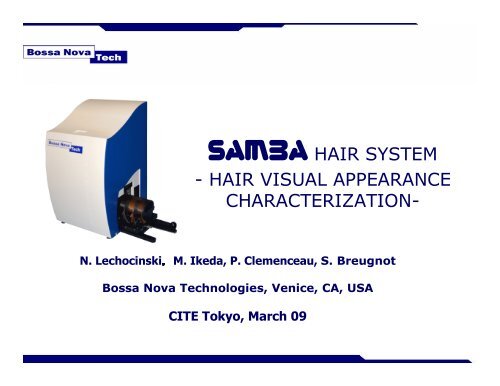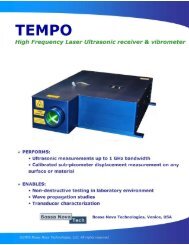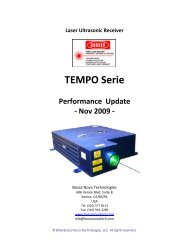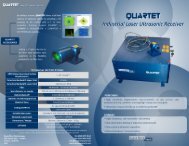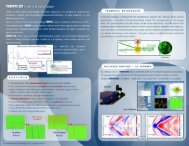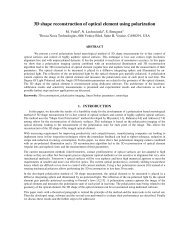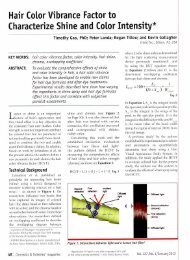SAMBAHAIR SYSTEM - HAIR VISUAL APPEARANCE ...
SAMBAHAIR SYSTEM - HAIR VISUAL APPEARANCE ...
SAMBAHAIR SYSTEM - HAIR VISUAL APPEARANCE ...
You also want an ePaper? Increase the reach of your titles
YUMPU automatically turns print PDFs into web optimized ePapers that Google loves.
SAMBA <strong>HAIR</strong> <strong>SYSTEM</strong><br />
- <strong>HAIR</strong> <strong>VISUAL</strong> <strong>APPEARANCE</strong><br />
CHARACTERIZATION-<br />
N. Lechocinski,M. Ikeda, P. Clemenceau, S. Breugnot<br />
Bossa Nova Technologies, Venice, CA, USA<br />
CITE Tokyo, March 09
• Bossa Nova Technologies company profile<br />
• Technical background :<br />
• Polarization, Interaction between light and sample, Hair visual appearance<br />
• Hair measurement setup :<br />
• Setup, Images acquired, Angular profiles<br />
• Luster parameter<br />
• Usual luster formulae, issue with polarization, new luster formula<br />
• Experimental results<br />
• On black, red and blond hair<br />
• Color analysis allows full understanding of light scattering<br />
• Comparison with goniophotometry<br />
• Video<br />
• Conclusion<br />
Table of contents
� LLC Created in 2002. Located in California, USA<br />
� Team of engineers and scientists specialized in optics, electronics,<br />
imaging and software development<br />
� Bossa Nova Technologies manufactures sensors, non destructive testing<br />
systems, and visual appearance measurement systems<br />
Systems for the cosmetic industry<br />
SAMBA<br />
Face System<br />
SAMBA<br />
Hair System<br />
Company profile
Light can be characterized by three fundamental properties :<br />
• its intensity<br />
• its spectrum (visible spectrum (color), also infrared, UV, …)<br />
• its polarization<br />
Technical background: Polarization of light<br />
Related to amplitude of light vibration<br />
Related to frequency/wavelength of light vibration<br />
Related to orientation of light vibration
Light source<br />
Vertical Polarizer<br />
Pigments<br />
Sample (Skin, hair…)<br />
DIFFUSED/SCATTERED LIGHT<br />
Depolarized Light<br />
Polarization is a tool to study light scattering.<br />
Technical background: light scattering<br />
It allows to separate reflections (specular light) from diffusion.<br />
We use it to characterize the visual appearance of hair.<br />
SPECULAR<br />
Polarization is<br />
preserved
Technical background: interaction of light with hair fibers<br />
POLARIZED<br />
Chroma= Colored band<br />
coming from the internal<br />
reflection<br />
Shine= White band<br />
coming from the<br />
reflection on the surface<br />
UNPOLARIZED<br />
Diffused light: uniform<br />
background color coming<br />
from internal scattering<br />
Visual appearance of hair can be measured by measuring the light scattering
The setup used is based on three main elements:<br />
• A polarized illumination (2)<br />
• A cylinder on which the sample is positioned (3)<br />
• A polarization camera (1)<br />
Hair System setup<br />
Polarized illumination and polarization camera allow<br />
measuring independently reflections and diffusion.<br />
Cylinder is used to record angular distribution profiles<br />
The cylinder also reproduces the human head<br />
curvature<br />
SAMBA Hair System is a visual setup based on polarization imaging
Hair System setup<br />
Each section on the image<br />
corresponds to an angle of<br />
incidence on the cylinder.<br />
Using a cylinder allows recording<br />
all angles on a single image,<br />
without moving the cylinder.<br />
This is a visual setup.
Polarization imaging physically separates reflections from diffusion on a complete<br />
hair tress in just seconds.<br />
Intensity image<br />
(seen by the eye)<br />
Specular image<br />
(reflections only)<br />
= +<br />
Acquisition of the images (data)<br />
Diffused image<br />
(internal scattering)<br />
Diffused light and reflections<br />
are physically separated<br />
without using fits or<br />
mathematical decomposition.<br />
As reflections are<br />
responsible of the luster<br />
sensation, polarization is a<br />
useful tool to help quantify<br />
luster.
Cross sections<br />
N orm a lize d units<br />
50<br />
40<br />
30<br />
20<br />
10<br />
0<br />
-45 -30 -15 0 15 30 45<br />
Angle (deg)<br />
From the images to the profiles and numerical data<br />
Specular image Diffused image<br />
Specular angular distributions<br />
(Luminance and color)<br />
Averaging<br />
along the<br />
hair tress<br />
L<br />
R<br />
G<br />
B<br />
N orm alized units<br />
6<br />
5<br />
4<br />
3<br />
2<br />
1<br />
0<br />
Diffused angular distributions<br />
(Luminance and color)<br />
-45 -30 -15 0 15 30 45<br />
Angle (deg)<br />
Characterization of the<br />
profiles with numerical<br />
parameters such as maxima,<br />
integrals and width<br />
L<br />
R<br />
G<br />
B<br />
LUSTER
Luster qualifies the visual appearance of the object.<br />
Luster is strongly linked to the idea of quality and beauty of an object.<br />
Scientists have tried to compute a parameter that would quantify the visual luster<br />
sensation.<br />
Luster sensation is considered to depend on 3 main parameters:<br />
The amount of<br />
reflected light<br />
Higher<br />
luster<br />
The more reflected light<br />
there is, the higher the<br />
luster is<br />
The sharpness of the<br />
reflection<br />
Higher<br />
luster<br />
The sharper the reflection is,<br />
the higher the luster is<br />
Luster parameter<br />
The background on which<br />
the reflection is observed<br />
Higher<br />
luster<br />
The darker the<br />
background is, the higher<br />
the luster is
Usual Luster formulae<br />
Several Luster formulae have been developed and published by scientists using<br />
goniometers and other instruments to tentatively quantify human perception of<br />
Luster.<br />
The parameters used in the formulae are :<br />
• S the total amount of the specular light<br />
• D the total amount of the diffused light<br />
•θ1/2<br />
the width of the specular light distribution<br />
The 4 most used formulae are:<br />
LRe ich − Robbins<br />
=<br />
S<br />
D*θθθθ<br />
1/<br />
2<br />
L<br />
TRI<br />
=<br />
S<br />
S + D<br />
θθθθ ref<br />
θθθθ 1/<br />
2<br />
Examples of luster formulae<br />
L Stamm<br />
S − D<br />
S<br />
These formulae were designed with a mathematical separation of specular<br />
and diffused light (curve fitting and other method).<br />
They can be used with the physical separation of diffused and specular light<br />
distribution with polarization.<br />
=<br />
L Guiolet =<br />
S<br />
D
Usual Luster formulae<br />
Bossa Nova Technologies luster:<br />
L<br />
New formula adapted to polarization imaging<br />
Using the existing formulae with polarization imaging does not always gives a good<br />
correlation with visual assessment (especially for dark hair).<br />
We developed a formula that is adapted to polarization imaging.<br />
It gives more dynamic range and better-correlated measurements.<br />
It works on every type of hair and especially on dark samples where other formula<br />
tended to lack sensitivity.<br />
BNT<br />
=<br />
Sin<br />
( D + S ) * W<br />
out<br />
visual<br />
Presented at the TRI conference in 2008.<br />
Article to come in the Journal of Cosmetic Science<br />
Small<br />
visual<br />
width<br />
large<br />
angular<br />
width
Experimental results: black hair<br />
Black hair<br />
Reflectance<br />
(Arbitrary Units)<br />
30<br />
25<br />
20<br />
15<br />
10<br />
5<br />
0<br />
Reich-Robbins<br />
+ 15.5 %<br />
TRI<br />
+ 26.8 %<br />
Black Hair<br />
-45 -30 -15 0 15 30 45<br />
Angle (deg)<br />
Specular Light Untreated<br />
Diffused Light Untreated<br />
Specular Light Treated<br />
Diffused Light Treated<br />
Bossa Nova Technologies<br />
+ 116.1 %
Red hair<br />
Reflectance<br />
(Arbitrary Units) Experimental results: red hair<br />
40<br />
35<br />
30<br />
25<br />
20<br />
15<br />
10<br />
5<br />
0<br />
Reich-Robbins<br />
+ 62.7 %<br />
TRI<br />
Red Hair<br />
-45 -30 -15 0 15 30 45<br />
Angle (deg)<br />
+ 33.5 %<br />
Specular Light Untreated<br />
Diffused Light Untreated<br />
Specular Light Treated<br />
Diffused Light Treated<br />
Bossa Nova Technologies<br />
+ 84.5 %
Experimental results: blond hair<br />
Reflectance<br />
(Arbitrary Units)<br />
50<br />
45<br />
40<br />
35<br />
30<br />
25<br />
20<br />
15<br />
10<br />
5<br />
0<br />
Reich-Robbins<br />
+ 80.1 %<br />
Blond Hair<br />
-45 -30 -15 0 15 30 45<br />
Angle (deg)<br />
TRI<br />
+ 43.7 %<br />
Specular Light Untreated<br />
Diffused Light Untreated<br />
Specular Light Treated<br />
Diffused Light Treated<br />
Bossa Nova Technologies<br />
+ 109.5 %
intensity<br />
Color analysis allows further understanding<br />
Usual Luster formulae<br />
Mathematical algorithm based on<br />
color information<br />
(Assuming that shine is white)<br />
Images calculated from profiles<br />
Color analysis allows a full decomposition<br />
of light scattering in hair fibers<br />
Intensity<br />
Shine<br />
Chroma<br />
Diffused<br />
Intensity= Shine + Chroma + Diffused<br />
New research focused on internal reflection ?<br />
New lusters taking into account chroma?
Color analysis allows further understanding<br />
The internal reflection (chroma) plays a big part in the visual appearance of hair<br />
Black Brown Red Blond<br />
Dark Bright<br />
• On untreated healthy hair, the shine (surface reflection) is comparable for all samples<br />
• As the hair becomes brighter, the chroma (internal reflection) increases as well as the diffused light<br />
• Chroma and diffused (carrying color information) play an important part on the visual appearance
Set-up<br />
Data<br />
Measurement<br />
process<br />
Shine-<br />
Chroma-<br />
Diffuse<br />
components<br />
separation<br />
GONIOPHOTOMETER<br />
Black box<br />
Angular Profiles only<br />
• Slow<br />
• On single fiber (or a few)<br />
• 1 angle at a time<br />
Use of mathematical fits and<br />
strong assumptions to<br />
separate shine-chromadiffuse<br />
components<br />
Comparison with goniophotometer<br />
SAMBA<br />
SAMBA<br />
SAMBA <strong>HAIR</strong> <strong>SYSTEM</strong><br />
Visual (verifiable with the eye)<br />
Angular Profiles + Images<br />
• On real tresses<br />
• All angles in one shot<br />
• No Mathematical fit<br />
• Physical extraction of diffuse<br />
component using polarization<br />
• Physical separation of shinechroma<br />
using color analysis
• SAMBA <strong>HAIR</strong> <strong>SYSTEM</strong> is a cutting-edge instrument that objectively quantifies visual<br />
appearance of hair<br />
• It uses a visual configuration (measurement verifiable with the human eye)<br />
• Easy to operate (one button operation, seconds for a measurements)<br />
• Well-known luster formulae are calculated in seconds on a complete hair tress<br />
• The system offers numerical data as well as images<br />
• A new BNT luster formula was developed to adapt to measurements made with polarization<br />
imaging<br />
• A powerful color analysis allows to fully understand light scattering on all types of hair.<br />
• SAMBA <strong>HAIR</strong> <strong>SYSTEM</strong> provides a new physical analysis of the internal reflection (chroma).<br />
New research should be conducted to evaluate the importance of chroma, leading to new lusters<br />
taking into account chroma in the formula.<br />
• A great tool widely used in the cosmetic industry to evaluate product efficacy, improve<br />
formulations and substantiate claims.<br />
Conclusion
Thank you<br />
Come see us on boothH-06(タレスレーザー株式会社)<br />
(Live demo of SAMBA Hair and Face systems)<br />
東京都大田区大森北2-16-4 大阪府吹田市広芝町9-12<br />
Bossa Nova Technologies<br />
606 Venice Blvd, Suite B<br />
Venice, CA 90291<br />
タレスレーザー タレスレーザー株式会社 株式会社<br />
USA<br />
東京都大田区大森北 大阪府吹田市広芝町 東京都大田区大森北<br />
Tel. 03-5753-4541(東京<br />
Tel.<br />
Tel. 310 577<br />
東京 東京)<br />
06-6192-7111(大阪<br />
info@thaleslaser.co.jp<br />
www.thaleslaser.co.jp<br />
8114 大阪 大阪) 大阪<br />
Email:<br />
info@bossanovatech.com<br />
www.bossanovatech.com


